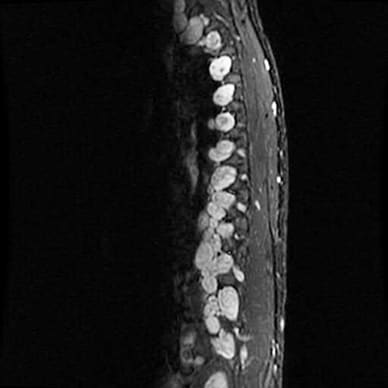March 01, 2019
Mayo Clinic's Neurofibromatosis Clinic provides multidisciplinary care for children and adults with neurofibromatosis type 1 (NF1) and neurofibromatosis type 2 (NF2). Both Neurofibromatosis Clinic locations — at Mayo Clinic's campuses in Phoenix/Scottsdale, Arizona, and Rochester, Minnesota — have been recognized by the Children's Tumor Foundation as providing comprehensive care for people with neurofibromatosis.
"Neurofibromatosis is a complex genetic disorder that requires expertise to manage. We have created a team that understands this rare disorder and that is passionate about caring for these patients," says Radhika Dhamija, M.B.B.S., a pediatric neurologist and geneticist who directs the Neurofibromatosis Clinic at Mayo Clinic's campus in Arizona.
العديد من الأورام العصبية الليفية على طول العمود الفقري الصدري القطني في الورم العصبي الليفي 1

العديد من الأورام العصبية الليفية على طول العمود الفقري الصدري القطني في الورم العصبي الليفي 1
يعرض التصوير بالرنين المغناطيسي العمود الفقري لمريض مصاب بالورم العصبي الليفي 1 (NF1)، العديد من الأورام العصبية الليفية على طول العمود الفقري الصدري القطني.
الورم الشفاني الدهليزي الثنائي والورم السحائي في حالة الإصابة بالورم العصبي الليفي 2 (NF2)

الورم الشفاني الدهليزي الثنائي والورم السحائي في حالة الإصابة بالورم العصبي الليفي 2 (NF2)
يعرض التصوير بالرنين المغناطيسي لدماغ مريض مصاب بالورم العصبي الليفي 2 (NF2)، الورم الشفاني الدهليزي الثنائي والورم السحائي.
Both NF1 and NF2 are characterized by the presence of nerve sheath tumors. Over time, NF1 and NF2 can cause wide-ranging complications that may not be limited to the nervous system. "Managing these patients over a lifetime requires knowing what to expect from this rare genetic disorder, which impacts not only patients but also their families," Dr. Dhamija says.
A "home" within Mayo Clinic
The Neurofibromatosis Clinic brings together specialists with experience managing both NF1 and NF2. Those specialists include:
- Neuro-oncologists
- Neurologic surgeons with expertise in brain tumors
- Neurologic surgeons with expertise in peripheral nerve surgery
- Neuro-otologists with experience removing tumors from the vestibular nerve
- Neuro-ophthalmologists
- Oncologists and radiation oncologists
- Otorhinolaryngologists
- Orthopedic surgeons
- Geneticists and genetic counselors
"The Neurofibromatosis Clinic functions as the patient's 'home' within Mayo," Dr. Dhamija says. "We start with an evaluation of the medical records and an initial visit with the patient. From there we can determine which particular specialists the patient needs."
Appointments are coordinated so that patients can generally see every needed specialist in a single visit to Mayo Clinic. Brain and spinal MRI might be done along with vision and hearing tests, and genetic testing to confirm the diagnosis. "Early diagnosis is especially important in children because they may not show symptoms initially," Dr. Dhamija says. "Confirming a diagnosis of neurofibromatosis allows us to start early surveillance for complications."
Mayo Clinic recommends annual checkups for patients with neurofibromatosis. "At these visits we go head to toe and talk about all of the issues that can arise with neurofibromatosis, including specific issues that can arise during pubertal growth, risks during pregnancy and heightened risk of breast cancer in young women with NF1," Dr. Dhamija says. "We understand the complications that can happen throughout these patients' lifetimes."
Geneticists and genetic counselors work with patients to find other family members at risk of neurofibromatosis. "We draw very detailed pedigrees," Dr. Dhamija says. "There are often other first-degree relatives who are at risk. We help them come to our Neurofibromatosis Clinic or can suggest other options.
"These patients tell us they want a physician who understands this rare disorder," Dr. Dhamija adds. "When a patient with neurofibromatosis has questions that their primary care provider cannot handle, they can call us at Mayo. We build very healthy, long-term relationships with patients and their families with this rare disorder."